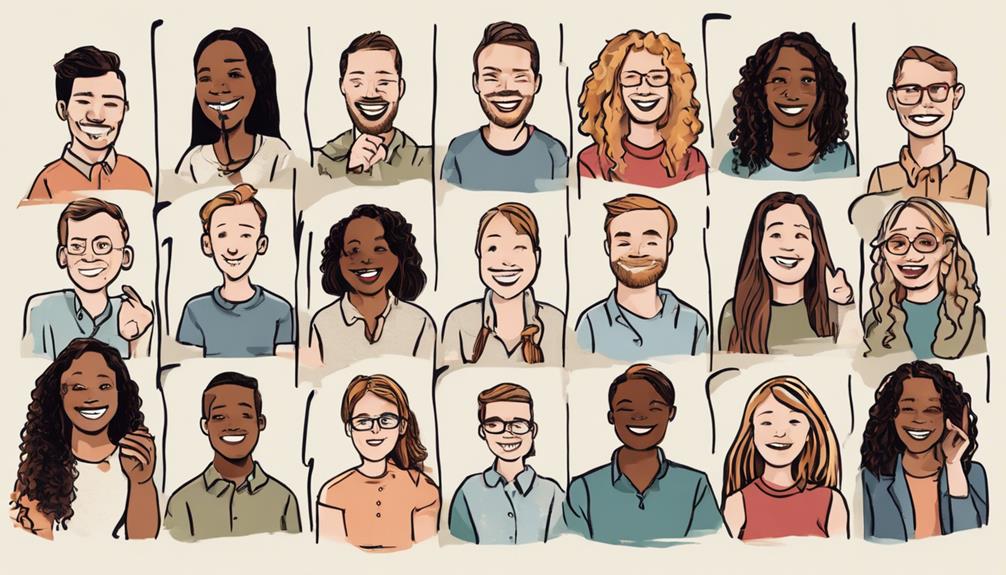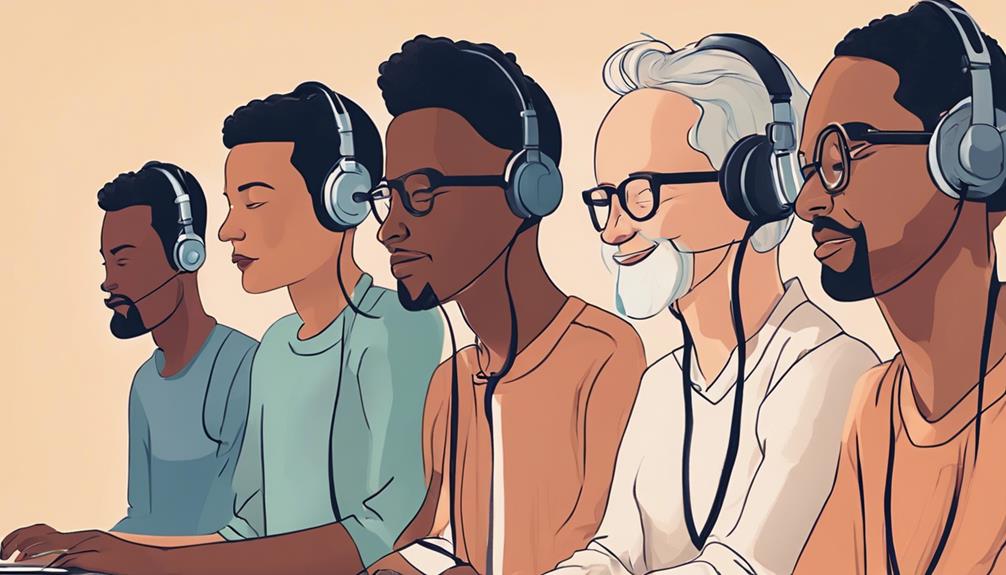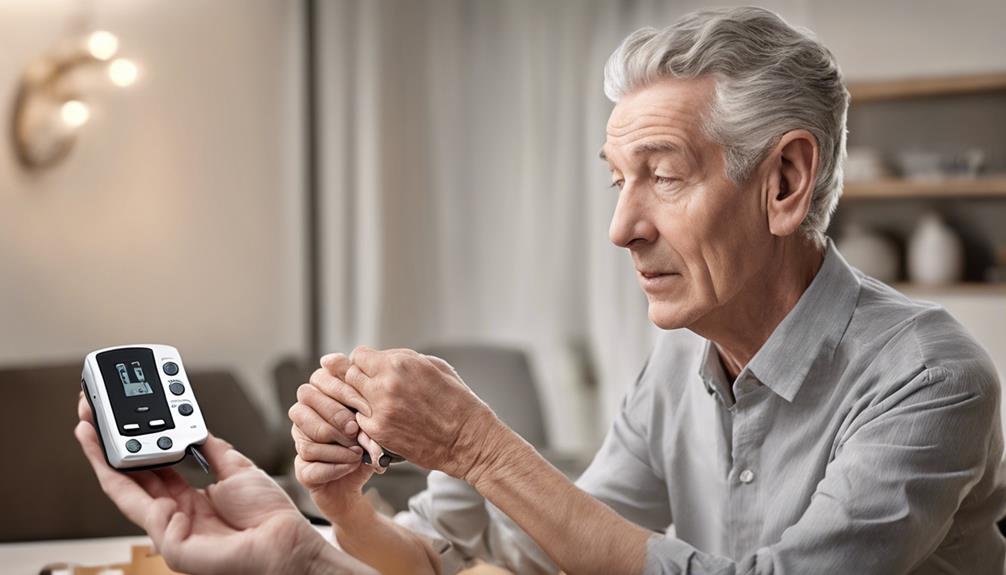Let’s discover 10 free online chat rooms for the deaf community to connect with others in a supportive environment.
These platforms offer diverse features for global messaging, video sharing, and more.
Each room provides a unique space for users to engage based on their preferences and interests.
Discover how these chat rooms can enhance your online interactions and foster a sense of community among deaf individuals.
Key Takeaways
- Deaf chat rooms offer global connectivity through messaging and video sharing.
- Empowering spaces foster belonging, skill enhancement, and cultural exchange.
- Online platforms unite deaf communities, celebrate shared experiences, and provide resources.
- Interactive rooms promote connections, learning, self-expression, and safe sharing of experiences.
DeafConnect Chat Room
Let's dive into the vibrant world of the DeafConnect Chat Room, where members engage in global conversations and share their experiences through various interactive features. The Deaf chat room is a hub of connectivity, offering a plethora of engaging options such as global messaging, multiple-choice questions, video sharing, and even blogging functionality. This dynamic platform allows users to host and join parties, fostering social interaction and facilitating group chats that spark creativity and collaboration.
Privacy is paramount in the DeafConnect Chat Room. To enter, identification is required, with customizable options like choosing a color, selecting age categories, and setting preferences. The room offers a free chatroom as well as a premium room with exclusive features such as no ads, unrestricted access, custom URLs, and private messages. These options cater to diverse user needs, ensuring a personalized and secure experience for all participants in the DeafConnect community.
ASL Friends Chat

Entering the realm of ASL Friends Chat opens the door to a vibrant online community where Deaf individuals engage in social interaction and communication through various interactive features. In this exciting chat room, users can:
- Global Messaging: Instantly connect with Deaf individuals from around the world, fostering a sense of unity and global camaraderie.
- Multiple Choice Questions: Engage in fun and interactive quizzes that not only entertain but also educate on various topics related to Sign Language and the Deaf community.
- Video Sharing in ASL: Share videos using American Sign Language, promoting a visual and expressive form of communication that resonates deeply with hard of hearing individuals.
ASL Friends Chat is more than just a platform; it's a gateway to a world where Sign Language is celebrated, and connections are forged. Through this innovative chat room, we can break barriers, celebrate diversity, and empower the Deaf community like never before. Join us in this digital space where every chat keystroke echoes the vibrant spirit of Sign Language and inclusion.
Deaf Community Hub
The Deaf Community Hub serves as a vibrant online space where individuals come together to connect, share experiences, and foster a sense of belonging and empowerment. This hub, built on the very essence of community, goes beyond the bare bones of a typical chat room. It's a virtual haven where innovation meets inclusivity, where the deaf community can thrive and amplify their voices.
Within this dynamic hub, we witness a tapestry of stories, ideas, and support woven together by individuals from diverse backgrounds. Here, the power of connection transcends barriers, creating a platform where every member is valued and heard. The evolving landscape of deaf chat rooms has seen shifts in design and functionality, reflecting a commitment to meeting the community's evolving needs.
As we navigate this digital realm, the Deaf Community Hub stands as a beacon of unity and progress, reminding us of the transformative potential when individuals come together with a shared purpose. Join us in this virtual sanctuary, where each keystroke contributes to the vibrant mosaic of the deaf community.
Sign Language Exchange

Engage in enriching sign language exchanges to enhance communication skills and foster a vibrant community of learning and connection. Sign language exchange offers a dynamic platform for individuals to practice and refine their signing abilities while engaging in meaningful conversations with others.
Here's how sign language exchange can benefit you:
- Skill Enhancement: Practice and improve your sign language proficiency through interactive exchanges with diverse users.
- Community Building: Connect with deaf individuals to share experiences, learn from each other, and build supportive relationships within a welcoming environment.
- Cultural Exchange: Embrace inclusivity and cultural diversity by engaging in sign language conversations with individuals who share a passion for enhancing communication through visual gestures.
Sign language exchange not only empowers you to communicate effectively but also creates a space where learning, connection, and growth thrive in an innovative and supportive community.
Silent Social Network
Let's celebrate the power of Silent Social Network in uniting online Deaf communities worldwide.
By connecting through sign language and accessible video chatrooms, we're fostering a vibrant and inclusive space for communication and friendship.
Join us in embracing this innovative platform that enhances our connections and celebrates our shared experiences.
Online Deaf Communities
Joining Silent Social Network opens doors to a vibrant online deaf community where connection and support thrive. Here, individuals share experiences, find understanding, and build lasting relationships.
Through Silent Social Network, we can:
- Engage in Meaningful Conversations: Dive into free deaf chat rooms to discuss diverse topics with fellow members.
- Participate in Community Events: Join virtual gatherings, workshops, and activities tailored to the deaf community's interests.
- Access Valuable Resources: Explore directories, educational materials, and insightful blog posts on hearing loss and coping strategies.
Together, we create a dynamic space where every voice is heard, valued, and empowered to make a difference. Join us in shaping the future of online deaf communities!
Connecting Through Sign Language
How can we strengthen our connections through sign language on Silent Social Network?
By embracing the power of ASL, we can transcend barriers and forge meaningful relationships within the deaf community.
Silent Social Network serves as a revolutionary platform where we can communicate, share stories, and engage in discussions entirely through sign language. This innovative approach not only fosters a sense of belonging but also empowers us to express ourselves authentically without the constraints of spoken language.
Through this digital space, we've the opportunity to connect on a deeper level, forming friendships that are built on understanding and shared experiences.
Let's harness the unique potential of sign language to create a vibrant and inclusive community where every individual feels heard and valued.
Accessible Video Chatrooms
Accessible video chatrooms on Silent Social Network provide a dynamic platform for deaf individuals to engage in real-time conversations using sign language videos, fostering inclusivity and enhancing visual communication within the deaf community.
These chatrooms offer a unique space where deaf users can interact, share experiences, and build connections through visual communication methods.
Through video chatrooms, deaf individuals can express themselves more effectively, leading to a deeper sense of community and understanding.
The innovative use of video technology in these chatrooms revolutionizes how deaf individuals communicate and connect with each other, breaking down barriers and creating a more inclusive environment for all participants.
Chatting Hands

Immerse yourself in the vibrant world of Chatting Hands, a dynamic free deaf chat room platform that fosters global connections through interactive messaging, engaging activities, and personalized experiences. Chatting Hands offers a range of features that make it a hub for innovative communication within the deaf community. Check out the table below to explore some of the exciting aspects of Chatting Hands:
| Features | Description | Benefits |
|---|---|---|
| Global Messaging | Connect with deaf individuals worldwide through real-time text-based conversations. | Enhances cultural exchange and global friendships. |
| Multiple Choice Questions | Engage in fun and interactive quizzes to test your knowledge and spark discussions. | Promotes learning and stimulates intellectual curiosity. |
| Video Posting | Share your experiences, stories, and creativity through videos with the community. | Fosters creativity and multimedia communication. |
Join Chatting Hands today to experience a new way of connecting with others and engaging in a vibrant online community that celebrates diversity and innovation.
Deaf Unity Room

Deaf Unity Room offers a vibrant and interactive chat platform for the deaf community to connect globally and engage in social activities. Here, users can feel a sense of belonging and empowerment through various features:
- Global Messaging: Connect with deaf individuals from around the world, breaking down geographical barriers.
- Video Posting: Share your experiences, thoughts, and creativity through videos, fostering a visual connection with others.
- Interactive Quizzes: Engage in fun and educational multiple-choice questions, promoting learning and friendly competition within the community.
Deaf Unity Room goes beyond just chatting; it's a space where individuals can express themselves, build relationships, and participate in diverse social events like parties and group chats. By requiring user identification with customizable options, the room ensures a safe and personalized experience for all.
For those seeking an enhanced chat environment, premium room options offer ad-free browsing, unique features, and private messaging capabilities, catering to different preferences and needs. Join us in Deaf Unity Room to connect, share, and thrive together!
Hearing Loss Lounge

Let's come together in the Hearing Loss Lounge to socialize with the Deaf community, sharing our experiences and tips.
We can connect, support, and uplift each other in a space that values our unique perspectives and voices.
Join us in creating a vibrant community where everyone feels heard and empowered.
Socializing With Deaf Community
Engage with a vibrant community of individuals who understand the challenges of hearing loss at the Hearing Loss Lounge for socializing with the deaf community. At the lounge, we offer a range of activities to foster connections and provide support:
- Open Chat Night Events: Join us on Wednesdays for lively interactions and engaging conversations with fellow community members.
- Shared Experiences: Share your journey and learn from others in a safe and welcoming environment that values every voice.
- Community Engagement: Feel a sense of belonging as we come together to empower one another through understanding and shared experiences.
Together, we create a space where innovation thrives, and relationships flourish. Join us at the Hearing Loss Lounge to connect, support, and grow!
Sharing Experiences and Tips
In our vibrant Hearing Loss Lounge, we foster a supportive environment where individuals share invaluable experiences and tips related to managing hearing loss. Through open discussions, we delve into coping strategies, challenges, and triumphs, creating a space for learning and growth. Our community thrives on exchanging insights on topics like tinnitus management and effective communication techniques. To enhance your journey, we offer a platform where advice, guidance, and a sense of belonging are readily available. Together, we empower each other to navigate the complexities of hearing loss with resilience and innovation.
| Benefits of Sharing | How to Contribute |
|---|---|
| Diverse Perspectives | Share Your Story |
| Practical Tips | Offer Support |
| Emotional Connection | Engage in Discussions |
SignChat Corner

SignChat Corner ignites vibrant connections among deaf individuals worldwide through its innovative free chat room platform. This dynamic space allows for engaging interactions and meaningful exchanges that foster a sense of community and support. Here's what sets SignChat Corner apart:
- Diverse Interaction: Users can ask multiple choice questions, post videos, and engage in blogging, creating a rich tapestry of communication options that cater to various preferences and interests.
- Enhanced Social Engagement: The chat room features party hosting options for group chats, elevating the social experience and encouraging lively discussions and connections among participants.
- Personalization and Safety: User identification through color selection, age categories, and optional preferences for customization not only adds a personal touch to interactions but also ensures a safe and welcoming environment for all participants.
SignChat Corner isn't just a platform; it's a vibrant community where deaf individuals can come together, share their stories, and forge lasting connections in a supportive online space.
Deafened Voices Forum

Connecting the deaf community with a platform for sharing experiences and finding support, Deafened Voices Forum serves as a valuable resource for individuals navigating hearing loss. This forum not only allows for engaging discussions but also provides a safe space for those with hearing loss to connect with others who understand their journey. One exciting feature of the forum is the open chat nights held every Wednesday, fostering a welcoming environment for interaction and support.
Here is a glimpse of what Deafened Voices Forum offers:
| Feature | Description |
|---|---|
| Open Chat Nights on Wednesdays | Engage in real-time conversations with others in the community during these special chat nights. |
| Educational Content and Blog Posts | Access valuable resources such as coping strategies and insights on various aspects of hearing loss. |
| Access Directories | Find directories for Audiologists, Speech Pathologists, and other resources for the deaf and hard of hearing community. |
Join us at Deafened Voices Forum to connect, learn, and empower each other on this shared journey!
Frequently Asked Questions
How Can I Meet Deaf People Online?
Meeting deaf people online is exciting! We can connect through platforms like DEAFCHAT.com, Camfrog, or Deaf Chat World. Engage in ASL chat rooms, join social media groups, and attend online events to expand our network.
Use deaf dating apps like Deaf And Dating for potential friendships or relationships. Let's embrace the digital world to meet amazing deaf individuals and foster meaningful connections!
Are There Any Free Chat Rooms Anymore?
Yes, there are still free chat rooms available, but the landscape has evolved. We've noticed a shift in the popularity of traditional chat rooms.
However, innovative platforms like Camfrog's ASL chat room are providing vibrant spaces for the deaf community to connect. Change is constant, but the spirit of connection remains strong.
Embrace new opportunities to engage with others and foster meaningful connections in this ever-evolving digital age.
Is There a Free Dating App for Deaf People?
Yes, there's a fantastic free dating app for deaf individuals. It enables users to create profiles, upload photos, search for matches, and send messages.
Premium membership unlocks unlimited messaging and advanced search filters for an even better experience. This app prioritizes creating a safe and welcoming space for the deaf community to connect and communicate.
Users must be 18 or older, and strict guidelines ensure respectful interactions.
How Do I Find a Deaf Person to Date?
When looking to find a deaf person to date, we recommend exploring specialized dating apps or websites catering to the deaf community. These platforms offer a unique opportunity to connect with individuals who understand and appreciate deaf culture.
What Are Some Online Platforms to Connect With the Deaf Community Outside of Events?
If you are looking to connect with the deaf community outside of deaf events in 2022, there are several online platforms available. Social media sites like Facebook and Instagram have deaf community groups where you can engage in discussions and connect with other members. Additionally, platforms like DeafConnect and Deaf Village offer online forums and resources for the deaf community.
Conclusion
As we sign off from our chat rooms, let's remember that our connections are like threads weaving a vibrant tapestry of support and understanding. Each interaction, each message, is a colorful stitch adding to the beauty of our community.
Let's continue to embrace diversity, share our stories, and uplift one another. Together, we create a masterpiece of unity and empowerment.
Keep chatting, keep signing, and keep spreading love in every conversation. We're stronger together.











